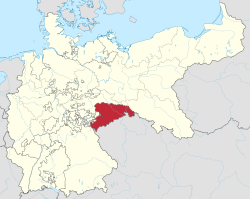
Back مملكة ساكسونيا Arabic مملكة ساكسونيا ARZ Saksoniya (krallıq) Azerbaijani ساکسونیا کراللیغی AZB Каралеўства Саксонія Byelorussian Кралство Саксония Bulgarian স্যাক্সনি রাজ্য Bengali/Bangla Rouantelezh Saks Breton Regne de Saxònia Catalan Saské království Czech
Kingdom of Saxony Königreich Sachsen (German) | |||||||||||
|---|---|---|---|---|---|---|---|---|---|---|---|
| 1806–1918 | |||||||||||
| Motto: Providentiae Memor (Latin for 'Providence Remember') | |||||||||||
| Anthem: Gott segne Sachsenland (1815) Sachsenlied ("Gott sei mit dir mein Sachsenland", 1842) | |||||||||||
 The Kingdom of Saxony within the German Empire | |||||||||||
 | |||||||||||
| Status |
| ||||||||||
| Capital | Dresden | ||||||||||
| Common languages | Standard German (written; educated speech) Upper Saxon German (colloquial) Upper Sorbian (in Upper Lusatia) | ||||||||||
| Religion | Lutheran (state religion),[1] but monarchs were Catholic | ||||||||||
| Demonym(s) | Saxon | ||||||||||
| Government |
| ||||||||||
| King | |||||||||||
• 1806–1827 | Frederick Augustus I (first) | ||||||||||
• 1904–1918 | Frederick Augustus III (last) | ||||||||||
| Minister-President | |||||||||||
• 1831–1843 | Bernhard von Lindenau (first) | ||||||||||
• 1918 | Rudolf Heinze (last) | ||||||||||
| Legislature | Landtag (1831–1918) | ||||||||||
• Upper Chamber | "First Chamber" | ||||||||||
• Lower Chamber | "Second Chamber" | ||||||||||
| Historical era | Napoleonic Wars / WWI | ||||||||||
| 11 December 1806 | |||||||||||
• Electorate raised to Kingdom | 20 December 1806 | ||||||||||
| 9 July 1807 | |||||||||||
• Occupied by Prussia | 1813 | ||||||||||
• Final Act of the Congress of Vienna | 9 June 1815 | ||||||||||
• Member of the North German Confederation | 1866 | ||||||||||
• State of the German Empire | 1 January 1871 | ||||||||||
• Frederick Augustus III abdicates | 13 November 1918 | ||||||||||
• Free State established | 1 November 1920 | ||||||||||
| Currency |
| ||||||||||
| |||||||||||
| Today part of | Germany Poland | ||||||||||
The Kingdom of Saxony (German: Königreich Sachsen) was a German monarchy that existed in Central Europe between 1806 to 1918. The territory of the Kingdom comprised from the former Electorate of Saxony. A member of historical confederacies, it joined the Confederation of the Rhine after the dissolution of the Holy Roman Empire, later joining the German Confederation after Napoleon was defeated in 1815. From 1871, it was part of the German Empire. It became a free state in the era of Weimar Republic in 1918 after the end of World War I and the abdication of King Frederick Augustus III of Saxony. Its capital was the city of Dresden, and its modern successor state is the Free State of Saxony.
- ^ Chadwick, Ulinka (2017). The Oxford Handbook of the Protestant Reformations. Oxford University Press. p. 106. ISBN 9780199646920.

